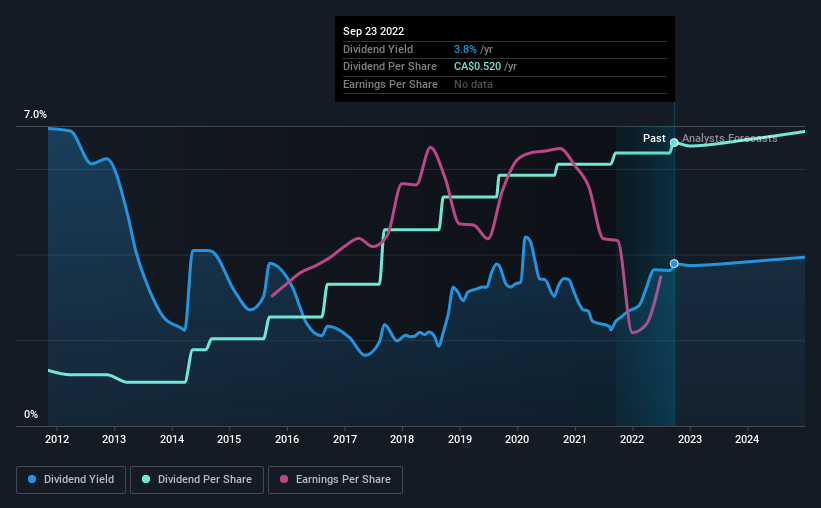It Might Not Be A Great Idea To Buy Savaria Corporation (TSE:SIS) For Its Next Dividend
Savaria Corporation (TSE:SIS) is about to trade ex-dividend in the next 3 days. The ex-dividend date is usually set to be one business day before the record date which is the cut-off date on which you must be present on the company's books as a shareholder in order to receive the dividend. The ex-dividend date is an important date to be aware of as any purchase of the stock made on or after this date might mean a late settlement that doesn't show on the record date. In other words, investors can purchase Savaria's shares before the 28th of September in order to be eligible for the dividend, which will be paid on the 7th of October.
The company's next dividend payment will be CA$0.043 per share, and in the last 12 months, the company paid a total of CA$0.50 per share. Based on the last year's worth of payments, Savaria stock has a trailing yield of around 3.8% on the current share price of CA$13.71. Dividends are an important source of income to many shareholders, but the health of the business is crucial to maintaining those dividends. We need to see whether the dividend is covered by earnings and if it's growing.
View our latest analysis for Savaria
If a company pays out more in dividends than it earned, then the dividend might become unsustainable - hardly an ideal situation. Savaria distributed an unsustainably high 166% of its profit as dividends to shareholders last year. Without more sustainable payment behaviour, the dividend looks precarious. A useful secondary check can be to evaluate whether Savaria generated enough free cash flow to afford its dividend. Over the past year it paid out 125% of its free cash flow as dividends, which is uncomfortably high. It's hard to consistently pay out more cash than you generate without either borrowing or using company cash, so we'd wonder how the company justifies this payout level.
Cash is slightly more important than profit from a dividend perspective, but given Savaria's payouts were not well covered by either earnings or cash flow, we would be concerned about the sustainability of this dividend.
Click here to see the company's payout ratio, plus analyst estimates of its future dividends.
Have Earnings And Dividends Been Growing?
When earnings decline, dividend companies become much harder to analyse and own safely. If business enters a downturn and the dividend is cut, the company could see its value fall precipitously. That's why it's not ideal to see Savaria's earnings per share have been shrinking at 3.7% a year over the previous five years.
The main way most investors will assess a company's dividend prospects is by checking the historical rate of dividend growth. Since the start of our data, 10 years ago, Savaria has lifted its dividend by approximately 18% a year on average. That's intriguing, but the combination of growing dividends despite declining earnings can typically only be achieved by paying out a larger percentage of profits. Savaria is already paying out 166% of its profits, and with shrinking earnings we think it's unlikely that this dividend will grow quickly in the future.
To Sum It Up
Is Savaria an attractive dividend stock, or better left on the shelf? It's looking like an unattractive opportunity, with its earnings per share declining, while, paying out an uncomfortably high percentage of both its profits (166%) and cash flow as dividends. Unless there are grounds to believe a turnaround is imminent, this is one of the least attractive dividend stocks under this analysis. It's not that we think Savaria is a bad company, but these characteristics don't generally lead to outstanding dividend performance.
With that being said, if you're still considering Savaria as an investment, you'll find it beneficial to know what risks this stock is facing. Every company has risks, and we've spotted 5 warning signs for Savaria (of which 2 shouldn't be ignored!) you should know about.
Generally, we wouldn't recommend just buying the first dividend stock you see. Here's a curated list of interesting stocks that are strong dividend payers.
Have feedback on this article? Concerned about the content? Get in touch with us directly. Alternatively, email editorial-team (at) simplywallst.com.
This article by Simply Wall St is general in nature. We provide commentary based on historical data and analyst forecasts only using an unbiased methodology and our articles are not intended to be financial advice. It does not constitute a recommendation to buy or sell any stock, and does not take account of your objectives, or your financial situation. We aim to bring you long-term focused analysis driven by fundamental data. Note that our analysis may not factor in the latest price-sensitive company announcements or qualitative material. Simply Wall St has no position in any stocks mentioned.
Join A Paid User Research Session
You’ll receive a US$30 Amazon Gift card for 1 hour of your time while helping us build better investing tools for the individual investors like yourself. Sign up here


